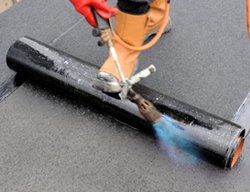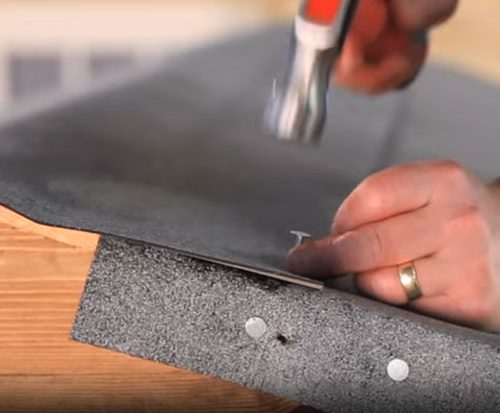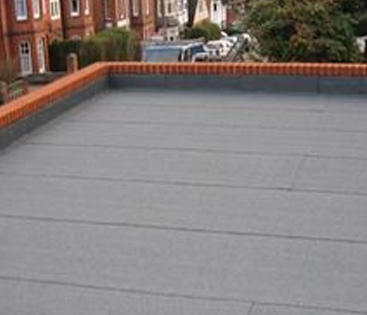Roofing felt keeps flat roofs watertight and has been used for over 100 years. It’s made from a mixture of bitumen, fibrous membrane and sand; it can be applied using two different techniques. With a lifespan of around 30 years and a mid-tier price point, it’s a solid choice for flat roofs and is suitable for some sloped roofs too.
Table of contents:
- Types of roofing felt
- What is roofing felt made from?
- What are the advantages of roofing felt?
- What are the disadvantages of roofing felt?
- How long does roof felt last?
- When should roof felt be replaced?
- How much felt will I need for my roof?
- What’s the difference between number 15 and number 30 roof felt?
- What are the alternative options to using roof felt?
- Final thoughts
Types of roofing felt
There are three types of roofing felt to consider for a roofing project; torch-on felt, self-adhesive felt and shed felt. There are many factors that can influence your decision, including whether you’re installing the roof yourself and the size of the project.
While torch-on felt is one of the quickest and most reliable flat roof installations, self-adhesive roofing felt is easier to apply yourself – you’ll find advantages and disadvantages to each roofing felt.
Torch-on felt
Torch-on felt has three layers of bitumen felt melt-welded onto the roof with a blow torch, creating a waterproof seal. Traditionally, these layers are made up of a vapour control sheet, reinforced felt and a cap sheet with a mineral finish. If you’re using the torch-on method for a habitable area of a home, building requirements stipulate the use of all three layers. However, for sheds and garages, only two may be required.
While this is one of the most reliable flat roofing solutions, it can be dangerous. The use of a hot flame in the application process means it’s only suitable to be laid by skilled roofers with experience in this field.
To hire an expert to cover a single garage you’d typically be looking to pay around £750-£850. This may seem like a lot, but it’s still cheaper than alternative flat roof coverings such as fibreglass. The lifespan of a torch-on felt roof is in the region of 15-25 years.
To find out more, check out our Roofing felt torch on essentials guide.
Self-adhesive felt
If you’re looking for a DIY project, self-adhesive felt is a great option. which allows the roof covering to be laid without the need for naked flames. So, it’s a solid choice if you’re planning to install the roofing felt yourself.
Once the release film is peeled off the bottom, the roof felt will self-bond to the substrate. This makes it ideal covering for small projects such as domestic flat roofs, garages and porches. It’s also cost-effective and results in a tough and durable roofing solution.
Shed felt
Shed felt is a roofing felt option suitable for sheds and garden buildings. Available in both torch-on and self-adhesive applications, it’s aesthetically pleasing and perfectly complements landscaped gardens. Although these types of constructions aren’t always considered for re-roofing, they depend on a weatherproof and waterproof finish – both of which shed felt can provide.
You might be wondering:
Do you need adhesive for shed felt?
You need to use both nails and adhesive when installing shed felt. Keep in mind that the bitumen in your shed felt will expand when the weather is warm and contract when it’s cold. So, you should use adhesive sparingly, allowing the bitumen some give and ensuring it doesn’t crack.
What is roofing felt made from?
These days, roof felting is largely made of modified bitumen mixed with either fibreglass or polyester. Typically, it tends to be the latter, as it’s extremely difficult to tear polyester. What’s more, it copes admirably with the usual movement associated with flat roofs. The combination of this and modified bitumen means felt roofing is tough and reliable and has a good lifespan.
While polyester and modified bitumen form a sturdy roof, it requires a final layer to protect it from the elements. Extreme cold can have a negative impact on roofing felts, but sunlight is the main enemy. It dries out the oils in the system, making it brittle, and can also cause heat expansion movement. These problems can be alleviated by adding a surface protection layer.
Luckily, there are many different options for that final protective layer, including lead flashings and labour-intensive solar reflective paint. However, a mineralised cap sheet will give you an attractive, maintenance-free finish, which accounts for the popularity of mineral felt flat roof solutions.
What are the advantages of roofing felt?
Felt is a low-cost roofing system that consistently performs. It’s a cornerstone of the roofing industry that offers customers value for money while being effective and easy to replace. As a material, felt is easy to work with and easy to transport, making it a great DIY option when you’re embarking on a self-build project.
And that’s not all:
Maintenance of a flat roof felt is typically quite low and doesn’t usually require a specialist. You can address repairs easily using weatherproof paint and sealant, keeping costs to a minimum.
Adding felt to your roof gives it a nice aesthetic appeal. While felt roofs tend to last between 10-30 years, many of the best roofing felt options can be recycled at the end of their lifespan, making this an eco-friendly option.
What are the disadvantages of roofing felt?
Like any roofing option, there are advantages and disadvantages to using roof felt. While it’s easy to repair, amendments can look scruffy and negatively impact the aesthetics of your project. After a series of repairs, it might be worth considering replacing the roof to restore it to its full potential.
In addition, the intense heat of summer and the harsh cold of winter can lead to weather damage, which can weaken the structure. You’ll also find that felt for roofing has a shorter lifespan than other flat roof materials, with most manufacturers guaranteeing the product for around 10 years.
How long does roof felt last?
There are many factors to consider when determining the lifespan of a flat felt roof. It largely depends on how well it’s been maintained over the years. While it’s true this type of roofing requires minimal maintenance, extreme weather can cause issues that need to be rectified.
However, the best roof felt, felt is extremely durable. The guarantee you get will depend on the manufacturer, but they usually offer at least 10 years of coverage on a felt roof. This is not necessarily indicative of the product’s lifespan as well-maintained torch-on heavy-duty roofing felt can last beyond 30 years.
When should roof felt be replaced?
With a typical lifespan of between 10 and 30 years, it can be hard to know exactly when you should replace your shed roofing felt. If you’re confident that the felt roof covering was fitted well, has been maintained and is promptly repaired when necessary, the chances are your roof will last closer to the 30-year mark.
However, nearing the end of its lifespan is not the only reason a felt roof needs replacing. Weather damage and organic growth can signify replacement is imminent.
Felt roof tears and cracks
Probably one of the easiest problems to spot, tears and cracks are typically the result of weather damage or potentially even the age of the roof. While small tears can be repaired cheaply and easily, a split across the entire surface warrants replacement. In this situation, time is of the essence, as failing to address a large tear promptly means moisture could seep in, leading to water damage in your home.
Bubbling and blistering in roofing felt
If the adhesive in the roof fails, you’ll notice bubbling and blistering appearing in the felt. When detected in the early stages, this is easily repairable. But if left to develop, the blisters can grow so large that the entire roof will need to be replaced. The other issue here is the potential for a blister to pop, which would create a hole in the flat roof. However, this generally only happens due to poor installation or inadequate ventilation at the construction stage.
Ponding on roof felt
If anything is likely to significantly reduce the lifespan of a felt roof, it’s ponding. When water is left standing on felt, it causes additional stress to the roof and can result in cracking and water penetration. Calling in a specialist is the best way to try to save the roof; but if the problem has been developing over time, you might find replacing the roof is the only available option.
Organic growth
A build-up of moss and algae might not seem like anything to worry about, but it does signify the retention of water on your flat roof. It might be because it lacked regular maintenance and, if left untreated, you could face additional problems with water damage. This will require the roof to be completely replaced.
Of course, the presence of moss might not mean anything serious is going on. That being said, it’s a good idea to conduct regular inspections to ensure no underlying problems are developing.
How much felt will I need for my roof?
In order to felt a roof, you’ll need to know exactly how much material is required for the project. For a flat roof, this requires simply measuring the length and width. But if there’s a slope to your roof, this needs to be factored in.
To determine the roof area of one side of a slope, simply multiply the length of your roof by the slope height. Most homeowners will have access to this information through building plans acquired with the property, but a local council should be able to help if this is not the case.
Our guide to calculating the roof area for a project provides more information on how to measure your roof.
What is the difference between the number 15 and number 30 roof felt?
The main difference between the two is thickness. Number 30 felt has a thicker layer of underlayment than number 15 felt, providing you with better protection but also adding extra weight to the roof. In general, number 15 is better for steeper roofs since rainwater will run off the surface quickly.
On the other hand, number 30 is better for flat roofs and less steep roofs where water will tend to linger longer and seep in.
What are the alternative options to using roof felt?
Felt roofing is a solid choice for a flat roof, but it’s not the only option on the market. GRP (glass reinforced plastic) and EPDM (rubber roofing) are also popular choices in the industry. GRP, in particular, has had a strong impact in the UK. But while its lifespan sits around 20-25 years it can be as much as £30 per metre more expensive than roofing felt prices.
EPDM rubber roofing has an impressive life expectancy of around 50 years. It repels moisture well and looks aesthetically pleasing, but the installation process is a lot more involved and typically requires a roofing specialist. If you’re embarking on a DIY project, self-adhesive grey roof felt is not only cost-effective but much easier to install too.
How to felt a roof
Most keen DIYers will have no trouble felting a roof. The process varies depending on whether you’re felting a flat or sloped roof. However, being lightweight, easy to install and budget-friendly, felt is a solid roofing choice.
Preparation is key, so remove any existing felt and ensure the surface is clean, replacing any rotten or damaged timber where necessary. You’ll also need to calculate the roof area, remembering to add around 5-7.5cm for overlaps at the edges and gables.
If you’re covering a flat roof, you’ll need to lay the felt out to rest before you can manipulate it into place. With a sloped roof, you can begin installing the felt as soon as you’re confident your calculations are correct.
Check out our step-by-step guide on how to felt a flat roof and a sloped roof for a full overview of the process.
Final thoughts
Roofing felt is a time-proven, durable and affordable solution that will keep your flat roof waterproof. It’s also relatively easy to install, making it a popular choice for DIYers. And with multiple options available on the market, you’re guaranteed to find the best felt roofing for your needs without any hassle.
If you have any questions about roofing felt products for your project or you want to know more about a specific project, don’t hesitate to get in touch and we’ll be happy to help.

















